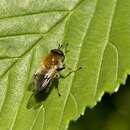fr
noms dans le fil d’Ariane


Criorhina is a genus of hoverflies.[16] Medium to large sized species, black or greenish black, with or without light ground markings mimicking bumblebees. The head is much flattened and broader than the thorax. The antennae are situated upon a prominent conical frontal process, The face is moderately produced below the eyes, downward or forward, in profile. The eyes are bare. The abdomen is elliptical or very short oval.[17] Larvae found in rot holes or decaying hardwoods [18]
Criorhina asilica (male)
{{cite journal}}: Cite journal requires |journal= (help) Criorhina is a genus of hoverflies. Medium to large sized species, black or greenish black, with or without light ground markings mimicking bumblebees. The head is much flattened and broader than the thorax. The antennae are situated upon a prominent conical frontal process, The face is moderately produced below the eyes, downward or forward, in profile. The eyes are bare. The abdomen is elliptical or very short oval. Larvae found in rot holes or decaying hardwoods
Criorhina es un género de mosca sírfida.[2][3]
Lista incompleta
Pelsblomsterfluer (slekten Criorhina) er en gruppe av fluer som tilhører familien blomsterfluer (Syrphidae). Slekten omfatter ca. 50 kjente arter, to av dem forekommer i Norge. De er knyttet til skog.
Middelsstore til store (8-18 mm) blomsterfluer, kroppsformen varierende, vanligvis ganske tett hårkledte. Ansiktet er påfallende forlenget nedover under fasettøynene – disse fluene er "side i geipen". Hodet er kort og bredt, fasettøynene er nakne og møtes i pannen hos hannene. Antennene sitter festet på et fremspring i pannen, men dette er nokså kort. Ansiktet er langt, tett bestøvet med en liten midtknøl. Thorax er tett kledt med oppstående hår av ulik farge – gulaktig, rødaktig eller svart. Bakkroppen er slank til kort oval, mer eller mindre tett hårkledt. Beina er relativt lange og slanke, baklårene litt fortykket, bakleggene litt krumme. Vingene har to eller tre brune tverrflekker hver.
Fluene er knyttet til skog med et innslag av døde eller døende løvtrær. Larvene utvikler seg i råtten ved eller under bark. De voksne fluene finnes gjerne på blomstrende busker og trær, der hunnene søker mat og hannene søker hunner.
Slekten forekommer i Palearktis og i Nord-Amerika.
Pelsblomsterfluer (slekten Criorhina) er en gruppe av fluer som tilhører familien blomsterfluer (Syrphidae). Slekten omfatter ca. 50 kjente arter, to av dem forekommer i Norge. De er knyttet til skog.
Pälsblomflugor (Criorhina och Pocota) är två närstående släkten i familjen blomflugor med stora och ofta humlelika arter.
Pälsblomflugor är stora flugor med en längd på mellan 8 och 18 millimeter. Färgen kan variera mycket, även inom samma art finns ofta flera färgformer. De har ett karaktäristiskt nedåt förlängt ansikte och korta antenner med nakna antennborst. Vingarna har mörka vingfläckar och i vila läggs de ofta parallellt och överlappande längs med kroppen.
Pälsblomflugor kan ses på blommande buskar som sälg, slån, hagtorn och hallon. Larverna utvecklas i förmultnande lövträdsved.
Släktet Criorhina har cirka 50 arter varav 19 i palearktis och sju i Europa. Släktet Pocota har endast två arter.
Följande fem arter förekommer i Norden och i Sverige.
Svenskt namn Vetenskapligt namn Utbredning i Sverige Hallonblomfluga Criorhina asilica Den vanligaste pälsblomflugan i Sverige. Förekommer upp till polcirkeln utom i fjällen. Törneblomfluga Criorhina berberina Skåne och västra Blekinge, lokalt ganska vanlig. Ullhårig pälsblomfluga Criorhina floccosa Enstaka fynd i Skåne, Blekinge och Småland. Rödlistad som sårbar. Humlelik pälsblomfluga Criorhina ranunculi Från Skåne till Mälardalen. Jordhumlefluga Pocota personata Från Skåne till Uppland.Pälsblomflugor (Criorhina och Pocota) är två närstående släkten i familjen blomflugor med stora och ofta humlelika arter.
Criorhina là một chi ruồi trong họ Syrphidae.[1]